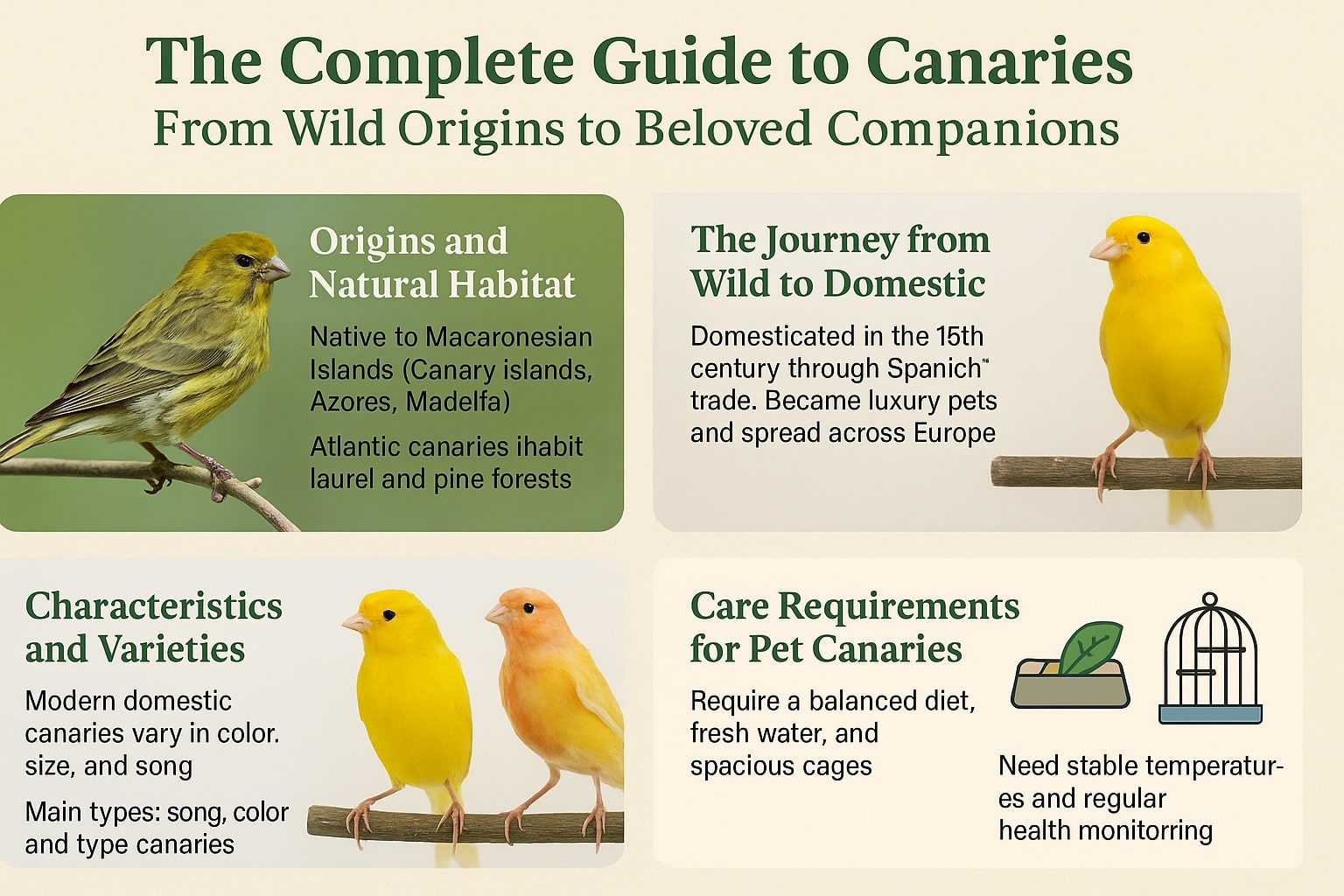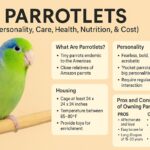Canaries represent one of the most successful stories of bird domestication, transforming from wild songbirds of the Atlantic islands into cherished pets that have captured human hearts for over five centuries.
These small, vibrant creatures have become synonymous with beautiful song and bright yellow plumage, though their story encompasses far more complexity than their common stereotypes suggest.
Today’s domestic canaries showcase remarkable diversity in color, size, and vocal abilities, all stemming from careful breeding practices that began in medieval Europe and continue to evolve in modern households worldwide.
Origins and Natural Habitat
The story of canaries begins in the Macaronesian Islands, specifically the Canary Islands, Azores, and Madeira, located in the Atlantic Ocean off the northwest coast of Africa1. The Atlantic canary, scientifically known as Serinus canaria, serves as the ancestor of all domestic canary varieties we know today.
These islands, which belong to Spain, provide diverse ecosystems that have shaped the natural behaviors and characteristics of wild canaries over thousands of years.
In their natural environment, wild canaries inhabit a remarkable range of landscapes, from coastal areas with sandy beaches to mountainous regions covered in lush vegetation. The birds primarily occupy laurel forests and pine forests found at higher altitudes on the islands. These laurel forests, known scientifically as laurisilva, create dense, humid environments characterized by tall trees, thick canopies, and rich undergrowth that provides both food sources and protected nesting sites.
The pine forests offer a contrasting habitat, featuring more open spaces with abundant sunlight filtering through Canary Island pine trees. Wild canaries adapt readily to both environments, demonstrating the flexibility that would later make them successful in captivity.
The natural diet of these birds consists of various seeds, fruits, and insects found throughout their island habitats. Their bright yellow-green plumage with brownish streaking serves as effective camouflage among the native vegetation.
Interestingly, the name “Canary Islands” does not derive from the birds themselves but rather from the Latin “canariae insulae,” meaning “islands of dogs,” referring to the large dogs kept by the original inhabitants. The birds later took their name from these islands, creating a linguistic connection that has persisted through centuries of human interaction with these remarkable creatures.
The Journey from Wild to Domestic
The domestication of canaries began in the late 14th or early 15th century when Spanish sailors and Portuguese explorers encountered these melodious birds during their conquests of the Macaronesian Islands.
The Europeans were immediately struck by the birds’ exceptional singing abilities, which differed markedly from any songbirds they had previously known. This initial fascination would soon develop into a carefully controlled trade that shaped European society for generations.
Spanish colonizers quickly recognized the commercial potential of these singing birds and established what would become one of history’s most successful animal trade monopolies.
Spanish maintained strict control over canary exports by keeping the birds’ island origins secret and selling only male birds to other European countries, including Portugal, England, France, and Italy1. Since only males possess the renowned singing ability, this strategy ensured that no other nation could establish independent breeding programs.
The exclusivity of canaries made them instant symbols of luxury and sophistication in 17th-century European courts. Aristocratic ladies and wealthy citizens paid enormous sums for these musical companions, driving prices to extraordinary heights. Spanish monasteries recognized the financial opportunity and began systematic breeding programs, further expanding the controlled supply while maintaining the prohibition on female exports.
According to historical legend, the Spanish monopoly ended around 1550 when a Spanish vessel carrying canaries for sale shipwrecked near the Italian port of Livorno. The escaped birds allegedly flew to the island of Elba, where they interbred with local bird species and were subsequently domesticated by Italian residents.
While the accuracy of this particular account remains debated among historians, Italian breeding programs certainly emerged during this period, leading to expanded trade with Tyrol, Switzerland, and Germany.
Characteristics and Varieties
Modern domestic canaries display remarkable diversity compared to their wild ancestors, thanks to centuries of selective breeding. While wild Atlantic canaries typically exhibit yellow-green plumage with brown streaking, domestic varieties showcase an extraordinary spectrum of colors, sizes, and feather patterns. The iconic bright yellow coloration that most people associate with canaries actually results from selective breeding that enhanced certain genetic traits while suppressing the melanins responsible for the original greenish coloration.
Domestic canaries fall into several main categories based on their primary breeding purposes. Song canaries, bred specifically for their vocal abilities, include famous varieties like the Harz Roller, which originated in Tyrol, Germany, during the 18th century.
These birds underwent vocal training by Russian breeders who were impressed by their natural mimicking abilities, resulting in canaries with distinctly modified songs compared to their wild relatives.
Color canaries represent another major category, bred primarily for their spectacular plumage variations. These birds may display solid colors, patterns, or combinations that would never occur in wild populations. Type canaries, the third major category, are bred for specific physical characteristics such as size, posture, or feather structure rather than color or song quality.
The vocal capabilities of domestic canaries deserve special attention, as they represent the only known case of pets whose vocalizations have been deliberately modified through human selection.
Male canaries naturally sing to establish territory and attract mates, but centuries of breeding have enhanced and refined these abilities far beyond what occurs in wild populations. Different breeds now exhibit characteristic song patterns, rhythms, and tonal qualities that experienced breeders can readily identify.
Care Requirements for Pet Canaries
Proper canary care requires understanding both the birds’ natural behaviors and their specific needs as domestic animals. Unlike many other pet birds, canaries are relatively low-maintenance creatures that can thrive in home environments with appropriate attention to their basic requirements.
However, their care should never be considered automatic or simple, as these sensitive birds depend entirely on their human caretakers for health and well-being.
Diet forms the foundation of canary health and vitality. These birds thrive on high-quality seed mixes specifically formulated for canaries, which provide balanced nutrition essential for their active metabolisms.
Supplementing the basic seed diet with fresh vegetables, fruits, and leafy greens such as kale, spinach, or grated carrots ensures optimal nutrition. Occasional treats like boiled eggs or fresh apple pieces provide additional nutrients while adding variety to their daily routine.
Fresh, clean water must be available at all times, both for drinking and bathing. Canaries are naturally clean birds that enjoy regular baths to maintain their feather condition. Providing a separate shallow dish for bathing allows them to engage in this important natural behavior while keeping their drinking water clean.
Housing requirements center on providing adequate space, proper perches, and environmental controls. Canaries need cages large enough to allow natural movement and short flights, with perches of varying thicknesses to promote healthy feet. Simple toys such as swings and mirrors can provide mental stimulation, though overcrowding should be avoided as it can cause stress.
Temperature and lighting play crucial roles in canary health. These birds require stable temperatures between 60-75°F (15-24°C) and should be protected from drafts or direct heat sources5. Natural sunlight supports their biological rhythms and overall health, though full-spectrum bird lights can substitute when natural light is insufficient.
Health Considerations and Veterinary Care
Canary health monitoring requires vigilance and understanding of normal versus concerning behaviors. Healthy canaries are active, alert, and maintain smooth, well-groomed feathers. Warning signs that require immediate veterinary attention include fluffed feathers, weakness, drooping wings, changes in water consumption, loss of appetite, and general decline in physical appearance.
Regular veterinary checkups with an avian-experienced veterinarian help detect health issues before they become serious problems. Canaries are prey animals that naturally hide signs of illness, making professional health assessments particularly important for early intervention when medical treatment might be most effective.
Respiratory health deserves special attention given canaries’ historical use in coal mining as early warning systems for carbon monoxide detection. This practice, which continued in the UK, Canada, and the US from the 18th through the 20th centuries, demonstrated both the birds’ sensitivity to air quality and their value to human safety. While this industrial use ended in the UK in 1986, it highlights the importance of maintaining clean air quality in modern homes where canaries are kept as pets.
The Cultural Impact and Future of Canaries
The influence of canaries extends far beyond their role as pets, having shaped language, culture, and even industrial safety practices. The phrase “canary in a coal mine” has become a common metaphor for early warning systems, while “canary yellow” represents a specific color shade recognized worldwide. These linguistic contributions reflect the deep integration of canaries into human culture over the past five centuries.
Modern canary keeping continues to evolve with advances in avian medicine, nutrition science, and breeding techniques. Contemporary breeders work to maintain genetic diversity while developing new varieties that combine desirable traits with robust health.
Conservation efforts also focus on protecting wild Atlantic canary populations in their native habitats, ensuring that future generations can appreciate both the domestic and wild forms of these remarkable birds.
The future of canary keeping appears bright, with new generations of bird enthusiasts discovering the joys of these musical companions. Educational programs and responsible breeding practices help ensure that canaries remain healthy, well-cared-for pets that continue to bring song and beauty into human lives just as they have for over 500 years.
From their origins on remote Atlantic islands to their current status as beloved household companions, canaries represent one of humanity’s most successful relationships with the natural world.
Their transformation from wild songbirds to diverse domestic varieties demonstrates both human ingenuity in animal husbandry and the remarkable adaptability of these small but extraordinary creatures.
- 9 Types of Lovebirds (A Comprehensive Guide for Pet Bird Owners) - June 20, 2025
- Labrador Retriever: America’s Most Beloved Family Dog - June 9, 2025
- The Complete Guide to Indian Ringneck Parrots - June 9, 2025















